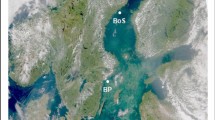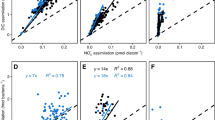Abstract
We investigated the role of N2-fixation by the colony-forming cyanobacterium, Aphanizomenon spp., for the plankton community and N-budget of the N-limited Baltic Sea during summer by using stable isotope tracers combined with novel secondary ion mass spectrometry, conventional mass spectrometry and nutrient analysis. When incubated with 15N2, Aphanizomenon spp. showed a strong 15N-enrichment implying substantial 15N2-fixation. Intriguingly, Aphanizomenon did not assimilate tracers of 15NH4+ from the surrounding water. These findings are in line with model calculations that confirmed a negligible N-source by diffusion-limited NH4+ fluxes to Aphanizomenon colonies at low bulk concentrations (<250 nm) as compared with N2-fixation within colonies. No N2-fixation was detected in autotrophic microorganisms <5 μm, which relied on NH4+ uptake from the surrounding water. Aphanizomenon released about 50% of its newly fixed N2 as NH4+. However, NH4+ did not accumulate in the water but was transferred to heterotrophic and autotrophic microorganisms as well as to diatoms (Chaetoceros sp.) and copepods with a turnover time of ~5 h. We provide direct quantitative evidence that colony-forming Aphanizomenon releases about half of its recently fixed N2 as NH4+, which is transferred to the prokaryotic and eukaryotic plankton forming the basis of the food web in the plankton community. Transfer of newly fixed nitrogen to diatoms and copepods furthermore implies a fast export to shallow sediments via fast-sinking fecal pellets and aggregates. Hence, N2-fixing colony-forming cyanobacteria can have profound impact on ecosystem productivity and biogeochemical processes at shorter time scales (hours to days) than previously thought.
Similar content being viewed by others
Log in or create a free account to read this content
Gain free access to this article, as well as selected content from this journal and more on nature.com
or
References
Bertilsson S, Berglund O, Karl DM, Chrisholm SW . (2003). Elemental composition of marine Prochlorococcus and Synechococcus: Implications for the ecological stoichiometry of the sea. Limnol Oceanogr 48: 1721–1731.
Capone DG, Zehr JP, Pearl HW, Bergmann B, Carpenter EJ . (1997). Trichodesmium, a globally significant marine Cyanobacterium. Science 276: 1221–1229.
Dabundo R, Lehmann MF, Treibergs L, Tobias CR, Altabet MA, Moisander PH et al. (2014). The contamination of commercial N-15(2) gas stocks with N-15-labeled nitrate and ammonium and consequences for nitrogen fixation measurements. PLoS One 9: e110335.
Engström J, Viherluoto M, Viitasalo M . (2001). Effects of toxic and non-toxic cyanobacteria on grazing, zooplanktivory, and survival of the mysid shrimp Mysis mixta. J Exp Mar Biol Ecol 257: 269–280.
Füssel J, Lam P, Lavik G, Jensen MM, Holtappel M, Günter M et al. (2012). Nitrit oxidation in the Namibian Oxygen Minimum Zone. ISME J 6: 1200–1209.
Hajdu S, Höglander H, Larsson U . (2007). Phytoplankton vertical distributions and composition in Baltic Sea cyanobacterial blooms. Harmful Algae 6: 189–205.
Holmes RM, Aminot A, Keroul R, Hooker BA, Peterson BJ . (1999). A simple and precise method for measuring ammonium in marine and freshwater ecosystems. Can J Fish Aquat Sci 56: 1801–1808.
Holtappels M, Lavik G, Jensen MM, Kuypers MMM (2011). 15N-labeling experiments to dissect the contributions of heterotrophic denitrification and anammox to nitrogen removal in the OMZ waters of the ocean. In: Martin GK (ed). Methods in Enzymology, vol. 486, Academic Press: Burlington, VT, USA, pp 223–251.
Ibelings BW, Maberly SC . (1998). Photoinhibition and the availability of inorganic carbon restrict photosynthesis by surface blooms of cyanobacteria. Limnol Oceanogr 43: 408–419.
Karlson AM, Duberg J, Motwani NH, Hogfors H, Klawonn I, Ploug H et al. (2015). Nitrogen fixation by cyanobacteria stimulates production in Baltic food-webs. Ambio 44: 413–426.
Kuypers MMM, Jørgensen BB . (2007). The future of single-cell environmental microbiology. Environ Microbiol 9: 6–7.
Larsson U, Hagström Å . (1982). Fractionated phytoplankton primary production, exudate release, and bacterial production in a Baltic eutrophication gradient. Mar Biol 67: 57–70.
Larsson U, Hajdu S, Walve J, Elmgren R . (2001). Baltic Sea nitrogen fixation estimated from the summer increase in upper mixed layer total nitrogen. Limnol Oceanogr 46: 811–820.
Lesutiene J, Bukaveckas PA, Gasiunaite ZR, Pilkaityte R, Razinkovas-Baziukas A . (2014). Tracing the isotopic signal of a cyanobacteria bloom through the food web of a Baltic Sea coastal lagoon. Estuar Coast Shelf Sci 138: 47–56.
Li Y-H, Gregory S . (1974). Diffusion of ions in sea water and in deep-sea sediments. Geochim Cosmochim Acta 38: 703–714.
McCarthy JJ, Goldman JC . (1979). Nitrogenous nutrition of marine phytoplankton in nutrient depleted waters. Science 203: 670–672.
Mohr W, Grosskopf T, Wallace DW, LaRoche J . (2010). Methodological underestimation of oceanic nitrogen fixation rates. PLoS One 5: e12583.
Menden-Deuer S, Lessard EJ . (2000). Carbon to volume relationships for dinoflagellates, diatoms, and other protest plankton. Limnol Oceanogr 45: 569–579.
Mulholland MR . (2007). The fate of nitrogen fixed by diazotrophs in the ocean. Biogeosciences 1: 37–51.
Mulholland MR, Capone DG . (2001). Stoichiometry of nitrogen and carbon utilization in cultured populations of Trichodesmium IMS101: implications for growth. Limnol Oceanogr 46: 436–443.
Musat N, Foster RA, Vagner T, Adam B, Kuypers MMM . (2012). Detecting metabolic activities in single cells with emphasis on nanoSIMS. FEMS Microbiol Rev 36: 486–511.
Ohlendieck U, Stuhr A, Siegmund H . (2000). Nitrogen fixation by diazotrophic cyanobacteria in the Baltic Sea and transfer of the newly fixed nitrogen to picoplankton organisms. J Mar Syst 25: 213–219.
Ploug H . (2008). Cyanobacterial aggregates formed by Aphanizomenon sp. and Nodularia spumigena in the Baltic Sea: Small-scale fluxes, pH and oxygen microenvironments. Limnol Oceanogr 53: 914–921.
Ploug H, Iversen MH, Fischer G . (2008). Ballast, sinking velocity and apparent diffusivity in marine snow and zooplankton fecal pellets: Implications for substrate turnover by attached bacteria. Limnol Oceanogr 53: 1878–1886.
Ploug H, Musat N, Adam B, Moraru CM, Lavik G, Vagner T et al. (2010). Carbon and nitrogen fluxes associated with the cyanobacterium Aphanizomenon sp. in the Baltic Sea. ISME J 4: 1215–1223.
Ploug H, Adam B, Musat N, Kalvelage T, Lavik G, Wolf-Gladrow D et al. (2011). Carbon, nitrogen, and O2 fluxes associated with the cyanobacterium Nodularia spumigena in the Baltic Sea. ISME J 5: 1549–1558.
Polerecky L, Adam B, Milucka J, Musat N, Vagner T, Kuypers MMM . (2012). Look@nanosims – a tool for the analysis of nanoSIMS data in environmental microbiologyemi. Environ Microbiol 14: 1009–1023.
Preisler A, de Beer D, Lichtslag A, Lavik G, Boetius A, Jørgensen BB . (2007). Biological and chemical sulfide oxidation in a Beggiatoa inhabited marine sediment. ISME J 1: 314–353.
Sherwood TK, Pigford RL, Wilke CR . (1975) Mass Transfer. McGraw-Hill Book Company: New York, USA.
Stal LJ, Albertano P, Bergman B, von Bröckel K, Gallon JR, Hayes PK et al. (2003). BASIC: Baltic Sea cyanobacteria. An investigation of the structure and dynamics of water blooms of cyanobacteria in the Baltic Sea-responses to a changing environment. Cont Shelf Res 23: 1695–1714.
Wagner M . (2009). Single-cell ecophysiology of microbes as revealed by Raman microspectroscopy or secondary ion mass spectrometry imaging. Annu Rev Microbiol 63: 411–429.
Walve J, Larsson U . (2007). Blooms of Baltic Sea Aphanizomenon sp.(Cyanobacteria) collapse after internal phosphorus depletion. Aquat Microb Ecol 49: 57–69.
Wannicke N, Korth F, Liskow I, Voss M . (2013). Incorporation of diazotrophic fixed N2 by mesozooplankton — case studies in the southern Baltic Sea. J Mar Syst 117–118: 1–13.
Warembourg FR (1993). Nitrogen Isotopes Techniques, Nitrogen Fixation in Soil and Plant Systems. In: Knowles K, Blackburn TH (eds). Academic: New York, USA, pp 157–180.
Wasmund N . (1997). Occurrence of cyanobacterial blooms in the Baltic Sea in relation to environmental factors. Int Rev Hydrobiol 82: 169–184.
Wasmund N, Voss M, Lochte K . (2001). Evidence of nitrogen fixation by non-heterocystous cyanobacteria in the Baltic Sea and re-calculation of a budget of nitrogen fixation. Mar Ecol Prog Ser 214: 1–14.
Woodland RJ, Holland DP, Beardall J, Smith J, Scicluna T, Cook PLM . (2013). Assimilation of diazotrophic nitrogen into pelagic food webs. PLoS One 8: e67588.
Zakrisson A, Larsson U, Höglander H . (2014). Do Baltic Sea diazotrophic cyanobacteria take up combined nitrogen in situ? J Plankton Res 36: 1368–1380.
Acknowledgements
We thank the staff at Stockholm University’s Baltic Sea Centre for their hospitality and support during this study at the Askö field station. We also thank Marcel Günter for his assistance in the field and during experiments, Gabriele Klockgether and Hannah Marchant for assistance with the MS analysis and Ragnar Elmgren for constructive comments to the manuscript. The Nordsim ion microprobe facility is operated under an agreement between the research funding agencies of Denmark, Iceland, Norway and Sweden, the Geological Survey of Finland and the Swedish Museum of Natural History. This work was supported by The Swedish Research Council for Environment, Agricultural Sciences and Spatial Planning, FORMAS (Grant no. 215-2009-813 to Ragnar Elmgren, JW and HP, and Grant no. 215-2010-779 to HP), the Max Planck Society (MPG), by the Baltic Ecosystem Adaptive Management programme (http://www.su.se/beam) to HP, the University of Stockholm, the University of Gothenburg and the Swedish Research Council (VR, Dnr: 621-2011-4406 to HP).
Author information
Authors and Affiliations
Corresponding author
Ethics declarations
Competing interests
The authors declare no conflict of interest.
Rights and permissions
About this article
Cite this article
Adam, B., Klawonn, I., Svedén, J. et al. N2-fixation, ammonium release and N-transfer to the microbial and classical food web within a plankton community. ISME J 10, 450–459 (2016). https://doi.org/10.1038/ismej.2015.126
Received:
Revised:
Accepted:
Published:
Issue date:
DOI: https://doi.org/10.1038/ismej.2015.126
This article is cited by
-
Diazotrophs are overlooked contributors to carbon and nitrogen export to the deep ocean
The ISME Journal (2023)
-
Single cell dynamics and nitrogen transformations in the chain forming diatom Chaetoceros affinis
The ISME Journal (2023)
-
Stable isotope analysis in food web research: Systematic review and a vision for the future for the Baltic Sea macro-region
Ambio (2023)
-
Nitrogen fixation estimates for the Baltic Sea indicate high rates for the previously overlooked Bothnian Sea
Ambio (2021)
-
Depicting Temporal, Functional, and Phylogenetic Patterns in Estuarine Diazotrophic Communities from Environmental DNA and RNA
Microbial Ecology (2021)



